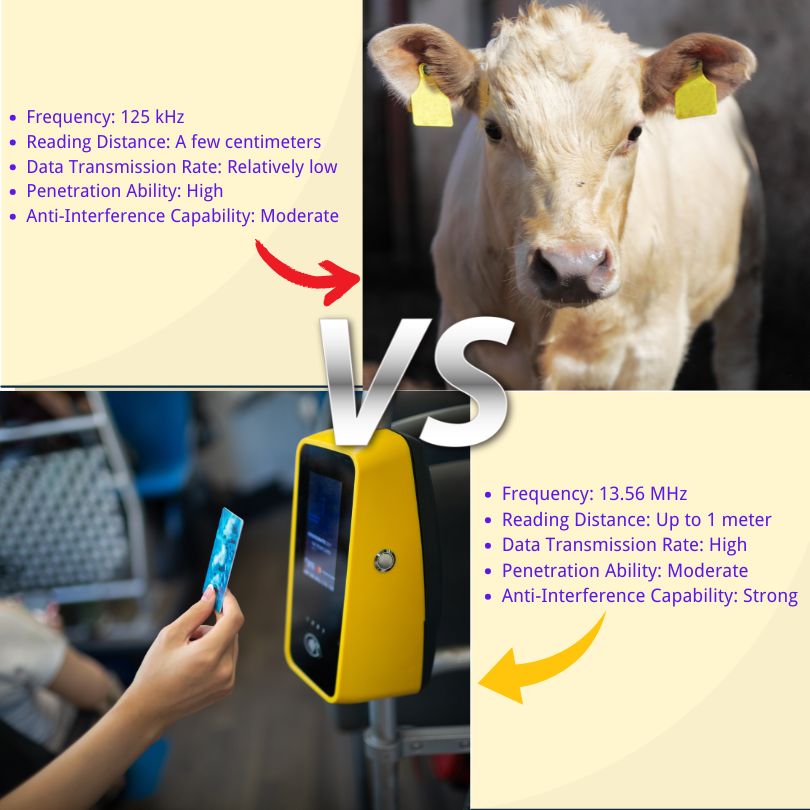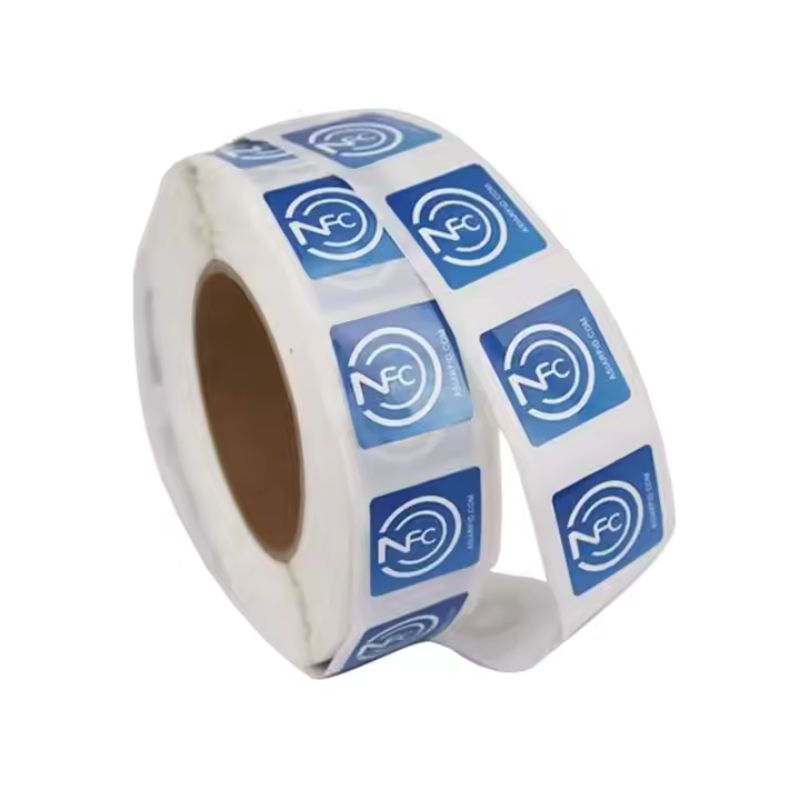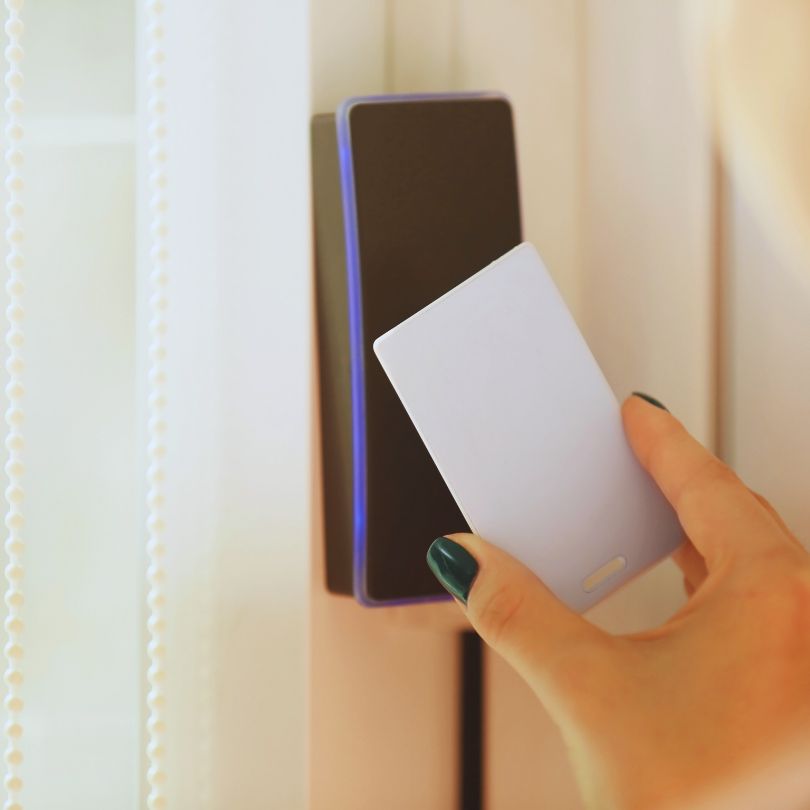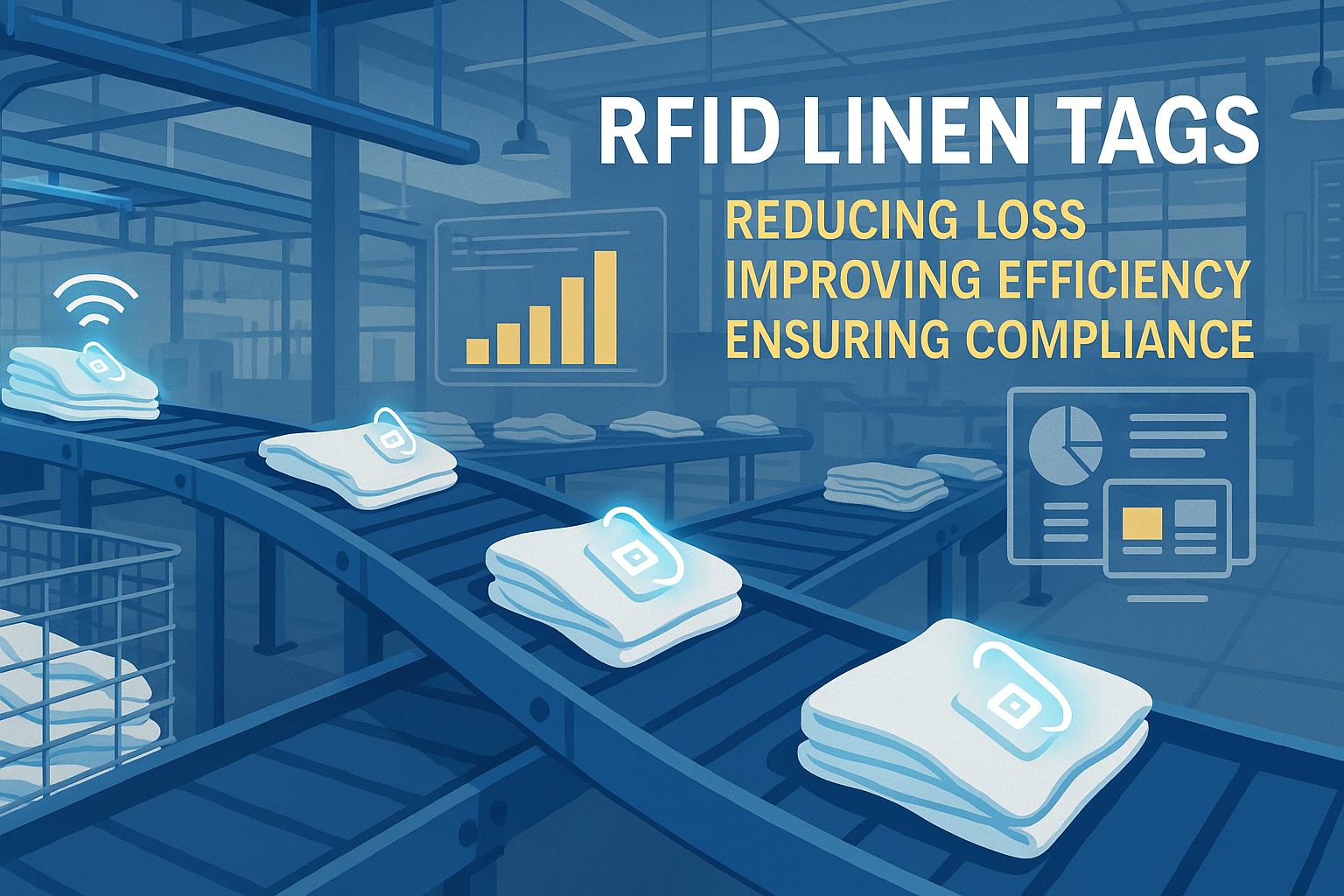
De verschillen tussen RFID-tags van 13,56 MHz en 125 kHz begrijpen
Inhoudsopgave
De verschillen tussen RFID-tags van 13,56 MHz en 125 kHz begrijpen

Wat RFID-frequentie werkelijk betekent (LF versus HF)
RFID-systemen gebruiken radiogolven om te communiceren tussen tags en lezers. De frequentie die ze gebruiken, beïnvloedt hoe ver ze kunnen lezen, hoe snel ze gegevens verzenden, hoe ze zich gedragen in de buurt van metaal of water en wat voor soort gegevens ze kunnen opslaan.
Dit is het kernidee:
Laagfrequente (LF) = 125 kHz RFID-tags
- Kort bereik
- Lagere gegevenssnelheid
- Uitstekende prestaties in de buurt van metaal of vloeistoffen
- Eenvoudig, robuust en betaalbaar
Hoge frequentie (HF) = 13,56 MHz RFID-tags - Groter bereik
- Hogere gegevenssnelheid
- Geavanceerdere beveiliging
- Compatibel met NFC en smartphones
13,56 MHz versus 125 kHz
| Functie | 13,56 MHz RFID-tags | 125 kHz RFID-tags |
|---|---|---|
| Frequentie | 13,56 MHz (HF) | 125 kHz (LF) |
| Leesbereik | Tot 1 meter | 2-10 cm |
| Gegevensoverdrachtssnelheid | Hoog | Laag |
| Prestaties in de buurt van metaal | Gematigd | Sterk |
| Beveiliging | Ondersteunt versleuteling, wederzijdse authenticatie | Basis, meestal geen versleuteling |
| NFC / Smartphone-ondersteuning | Ja | Nee |
| Kosten | Hoger | Lager |

Beveiliging: is één frequentie veiliger?
125 kHz RFID-tags worden vaak gebruikt in oudere systemen en maken doorgaans gebruik van vaste unieke ID's zonder versleuteling. Daardoor zijn ze gemakkelijk te klonen met standaardapparatuur. Ze zijn geschikt voor systemen met een laag risico, maar voldoen niet aan de moderne beveiligingsnormen.
13,56 MHz RFID-tags, met name MIFARE- of DESFire-kaarten, ondersteunen:
- Encryptie
- Wederzijdse authenticatie
- Veilige geheugenopslag
- Meerdere toepassingen op één kaart
Conclusie: - Gebruik 125 kHz RFID-tags voor lage beveiligingsbehoeften (zoals kluissleutels, tijdklokken).
- Kies 13,56 MHz voor toegangscontrole, betalingen of elk systeem dat persoonlijke gegevens opslaat.
NFC en smartphone-compatibiliteit
Als uw project betrekking heeft op telefoons, zullen 125 kHz RFID-tags niet werken.
Alleen 13,56 MHz RFID-tags ondersteuning voor NFC (Near Field Communication) – de technologie die wordt gebruikt voor mobiele betalingen, check-ins en tap-to-pair-functies.
De meeste smartphones kunnen NFC-tags lezen en schrijven met 13,56 MHz, waardoor deze frequentie ideaal is voor:
- Digitale tickets
- Evenement check-ins
- Slimme posters
- Loyaliteitskaarten
- Contactloze mobiele ID
Als smartphone-ondersteuning belangrijk is, is 13,56 MHz uw enige keuze.
Praktijkvoorbeelden per branche
| Industrie / Toepassing | 125 kHz RFID-tags | 13,56 MHz RFID-tags |
|---|---|---|
| Toegangscontrole | Basis toegangssystemen, oude deuren | Beveiligde inloggegevens, moderne ID-badges |
| Openbaar vervoer / Ticketing | Niet ondersteund | MIFARE/NFC-gebaseerde vervoerskaarten |
| Dieren volgen | Veel gebruikt vanwege de penetratie in het weefsel | Zeldzaam |
| Industriële Automatisering | Betrouwbaar in de buurt van metaal/vloeistoffen, robuust gebruik | Minder gebruikelijk in ruwe omgevingen |
| Gezondheidszorg | Niet ideaal voor het volgen van patiënten of medicatie | Beter voor veilige ID- en asset-tagging |
| Bibliotheken / Archieven | Zeldzaam | Populair voor het bijhouden van boeken en het uitchecken ervan |
| Marketing / Evenementen | Niet van toepassing | Slimme posters, NFC-evenementpassen |
| Antidiefstal voor voertuigen | Ingebouwde 125 kHz RFID-tags in sleutels/contactsloten | Niet gebruikt |

Hoe u tussen 13,56 MHz en 125 kHz kunt kiezen voor uw project
Gebruik deze checklist om uw beslissing te verfijnen:
1. Beveiligingsniveau
- Heb je encryptie of beveiligde toegang nodig? → Kies dan voor 13,56 MHz.
- Lage risico tracking of basis-ID? → 125 kHz kan voldoende zijn.
2. Milieu
- Veel storing, metaal of vloeistof in de buurt? → 125 kHz werkt beter
- Schoon kantoor of binnenruimte? → Beide zijn mogelijk; kies op basis van de functies.
3. Integratie met smartphones
- Wilt u dat gebruikers met hun telefoon kunnen scannen? → Alleen 13,56 MHz ondersteunt dit.
4. Begroting
- 125 kHz-tags zijn in eerste instantie goedkoper
- Maar 13,56 MHz biedt meer waarde op lange termijn als u functies of beveiliging nodig hebt.
Gebruikt u nog steeds 125 kHz RFID-tags? Upgraden of blijven?
125 kHz RFID-tags worden nog steeds veel gebruikt in:
- Verouderde toegangscontrolesystemen
- Fabrieksvloeractiviteiten
- Het merken van vee
- Automatische antidiefstalsystemen
Maar als je het volgende doet: - Referenties van medewerkers
- Betalingssystemen
- Multifunctionele ID-kaarten
- NFC-integratie
... dan is het misschien tijd om over te stappen.
Upgrade-paden:
- Installeer dual-frequency lezers
- Combo-kaarten uitgeven (ondersteunt zowel 13,56 MHz als 125 kHz)
- Geleidelijke uitrol: ondersteuning van beide systemen tijdens de migratie
Veelgestelde vragen over 13,56 MHz versus 125 kHz RFID
Is 13,56 MHz hetzelfde als NFC?
Ja, NFC is een type 13,56 MHz RFID. De meeste smartphones ondersteunen dit.
Kan één lezer beide frequenties lezen?
Meestal niet. Je hebt een lezer met dubbele technologie nodig om beide te kunnen verwerken.
Welke tag heeft een groter bereik?
13,56 MHz heeft over het algemeen een groter leesbereik (tot 1 meter). 125 kHz is beperkt tot enkele centimeters.
Welke moet ik gebruiken voor toegangscontrole?
Voor moderne, veilige toegangssystemen wordt 13,56 MHz sterk aanbevolen.
Waarom hebben RFID-tags van 13,56 MHz en 125 kHz verschillende leesafstanden?
Het verschil in leesafstanden is voornamelijk te wijten aan de werkfrequentie. Hogere frequenties zoals 13,56 MHz hebben een groter bereik, terwijl lagere frequenties zoals 125 kHz geoptimaliseerd zijn voor kortere afstanden.
Welke RFID-tag is het meest geschikt voor metaal- of vloeistofomgevingen?
RFID-tags van 125 kHz zijn effectiever in omgevingen met metalen of vloeistoffen vanwege hun superieure penetratievermogen.
Heeft de prijs van RFID-tags invloed op de keuze?
Ja, 125 kHz RFID-tags zijn over het algemeen kosteneffectiever, waardoor ze een geschikte optie zijn voor budgetbewuste toepassingen. De keuze moet echter ook rekening houden met prestatievereisten en toepassingsomgevingen.
Belangrijkste normen en chiptypes
13,56 MHz (HF)
- ISO/IEC 14443: Gebruikt in contactloze kaarten (MIFARE, DESFire)
- ISO/IEC 15693: groter bereik, gebruikt in bibliotheken, logistiek
- ISO 18000-3: Tracking op itemniveau
125 kHz (LF)
- Eigen formaten, vaak met vaste ID (bijv. EM4100, HID Prox)
- Wordt vooral gebruikt in oudere systemen en basistoepassingen
Laatste conclusies
Als je nog steeds twijfelt welke weg je moet inslaan, volgt hier een samenvatting:
Gebruik 125 kHz RFID-tags voor:
- Zware omstandigheden (metaal/vloeistof)
- Toepassingen met lage beveiliging
- Budgetbewuste implementaties
- Legacy-systemen
Gebruik 13,56 MHz RFID-tags voor:
- Ondersteuning voor mobiel/NFC
- Veilige toegang en betaling
- Multifunctionele kaarten
- Toekomstbestendige systemen
Beide hebben hun plaats, maar je moet je keuze baseren op het gebruik, niet alleen op de kosten of gewoonte.
Reacties
Populaire producten

Wat is RFID-afvalbeheer?
Stel je een stad voor waar elke vuilnisbak spreekt – niet letterlijk – maar via een kleine chip die het systeem laat weten wanneer hij vol is, wanneer hij wordt geleegd en waar hij naartoe gaat. Dat is wat RFID-afvalbeheer vandaag de dag doet.

Wat zijn boutafdichtingen en hun toepassingen? | Complete gids
In de wereldwijde handel en logistiek spelen grendelafdichtingen een cruciale rol bij het garanderen van de veiligheid en naleving van de vrachtwetgeving. Deze kleine maar krachtige apparaten zijn ontworpen om zeecontainers, trailers en vrachtdeuren te vergrendelen met een mechanisme dat knoeien onmogelijk maakt.

Wat is een RFID-kaartbeschermer? Voordelen, gebruik en koopgids
RFID-technologie (Radio Frequency Identification) is overal: in je creditcards, identiteitskaarten, vervoerspassen, sleutels van hotelkamers en nog veel meer. Het biedt snelheid en gemak, maar het opent ook de deur naar een nieuwe vorm van digitale diefstal die "skimming" wordt genoemd. Dat is waar een RFID kaartbeschermer om de hoek komt kijken.

RFID-polsbandjes voor evenementen: Bulk-inkoopgids voor organisatoren
RFID-polsbandjes voor evenementen worden steeds meer de oplossing voor organisatoren die snellere toegang, fraudepreventie en cashloze betalingen nodig hebben voor concerten, festivals en sportlocaties. In tegenstelling tot papieren tickets of QR-codes gebruiken deze slimme polsbandjes ingebouwde chips om de toegang te stroomlijnen, transacties te beveiligen en de gastervaring te verbeteren.

Hoe RFID-tag op voorruit toegangscontrole en tolsystemen voor voertuigen verbetert
In de snelle wereld van vandaag moet voertuigidentificatie snel, veilig en contactloos zijn. Een RFID Tag op de voorruit biedt precies dat - een betrouwbare manier om tolheffing, parkeren en toegangspoorten te beheren zonder voertuigen te stoppen.

De voordelen van RFID linnen Tags in commerciële wasserijen
De was beheren in ziekenhuizen, hotels of grote wasserijen is een hele klus. Elke dag worden duizenden lakens, handdoeken en uniformen gewassen, gesorteerd en teruggestuurd. Maar problemen zoals verloren linnengoed, sorteerfouten en handmatige telling kunnen bedrijven veel geld kosten. Middelgrote hotels kunnen bijvoorbeeld elk jaar meer dan $200.000 verliezen door zoekgeraakt beddengoed.
Dat is waar RFID Linen Tags van pas komen.
Labels
GERELATEERDE BLOGS

Wat is RFID-afvalbeheer?
Stel je een stad voor waar elke vuilnisbak spreekt – niet letterlijk – maar via een kleine chip die het systeem laat weten wanneer hij vol is, wanneer hij wordt geleegd en waar hij naartoe gaat. Dat is wat RFID-afvalbeheer vandaag de dag doet.

Wat zijn boutafdichtingen en hun toepassingen? | Complete gids
In de wereldwijde handel en logistiek spelen grendelafdichtingen een cruciale rol bij het garanderen van de veiligheid en naleving van de vrachtwetgeving. Deze kleine maar krachtige apparaten zijn ontworpen om zeecontainers, trailers en vrachtdeuren te vergrendelen met een mechanisme dat knoeien onmogelijk maakt.

Wat is een RFID-kaartbeschermer? Voordelen, gebruik en koopgids
RFID-technologie (Radio Frequency Identification) is overal: in je creditcards, identiteitskaarten, vervoerspassen, sleutels van hotelkamers en nog veel meer. Het biedt snelheid en gemak, maar het opent ook de deur naar een nieuwe vorm van digitale diefstal die "skimming" wordt genoemd. Dat is waar een RFID kaartbeschermer om de hoek komt kijken.




